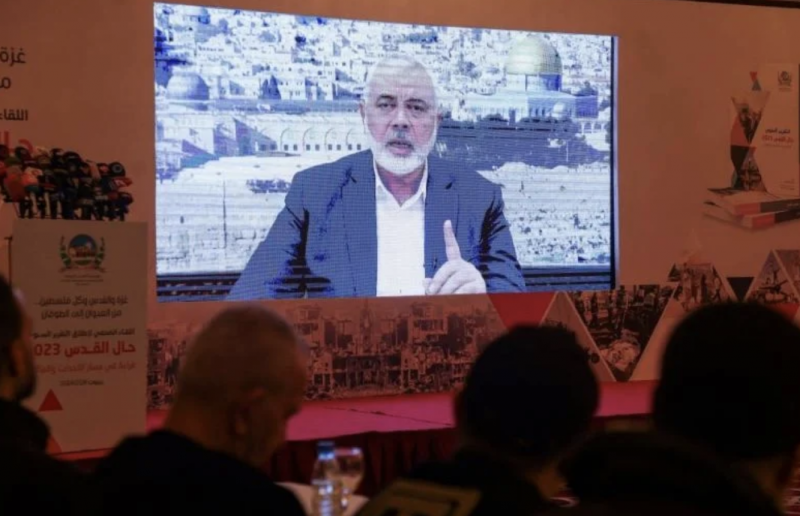
Hamas Political Bureau Chief Ismail Haniyeh delivering a pre-recorded message broadcast during a press conference at the al-Quds International Institution, Beirut, Feb. 28, 2024. (Credit: Mohammad Azakir/Reuters)
This escalation in violence came amidst heightened tensions between Hezbollah and the Israeli army in the area.
The resurgence of Hamas’ activity was a surprise, especially considering its recent period of relative quietude in the public eye.
The official justification provided for this extensive operation is in response to what Hamas said are “Zionist massacres against civilians in the Gaza Strip” and the assassination of Saleh al-Arouri, the second-in-command in Hamas, along with six of his associates, according to a statement from the movement.
The attack targeting Arouri occurred in the heart of the southern suburbs of Beirut on Jan. 2.
Raising the stakes
The rationale behind this operation may extend beyond the stated reasons. The group had refrained from claiming any operations from Lebanon since November.
The context is crucial: Against the backdrop of stalled negotiations, spearheaded by Qatar and aimed at securing a lasting ceasefire in Gaza, Hamas’ military activity in Lebanon is viewed as a strategic move to apply pressure and strengthen its position at the negotiating table.
This resurgence in military action signals Hamas’ resolve to maintain its stance and pursue its objectives unabated.
“It appears that the negotiations in Doha have hit a deadlock,” said Karim Bitar, a political analyst. “Hamas is now upping the ante.”
Another factor to consider is the recent escalation by Israel, which has expanded the scope of its strikes in Lebanon. Last Monday marked the first time since the 2006 war that Israeli raids targeted the predominantly Shiite Baalbeck area in the Bekaa, located approximately 100 kilometers from the border.
This development is believed to have spurred Hamas, in collaboration with Hezbollah, to claim responsibility for firing the 40 Grad rockets.
“Hamas typically operates under the leadership of Hezbollah,” said Suheil Natour, a member of the Democratic Front for the Liberation of Palestine (DFLP). “If it refrained from sponsoring military operations recently, it’s likely because the party was already taking action, particularly as the clashes remained within a certain scale.”
Furthermore, it remains uncertain if Hamas was behind the missile launches, as Hamas and Hezbollah have both been actively involved in the conflict since its inception.
Yet, in this instance, Hezbollah appeared inclined to credit Hamas for the action.
A source with close ties to Hezbollah claimed that the rockets targeting Safed, a military installation in northern Israel, on Feb. 14, were “unquestionably orchestrated by Hamas” rather than Hezbollah. Nevertheless, neither of the pro-Iranian factions officially claimed responsibility for the assault.
It’s also crucial to consider that Hamas often faces constraints, particularly in the presence of the Lebanese Army, even if its presence is not heavily concentrated along the southern border.
“Although the army may cooperate to some extent with Hezbollah, it refrains from doing so with Palestinian factions in Lebanon,” said a source affiliated with Hezbollah on condition of anonymity due to the sensitivity of the issue.
The source underscored the distinction made in successive ministerial statements, which endorse the concept of “resistance” but do not explicitly endorse the actions of Palestinian factions operating within Lebanon.
Calling again for the ‘unity of fronts’
The resurgence of the Palestinian movement’s activity is also believed to be tied to Israel’s threats of attacking Rafah, the area bordering Egypt, which has become a refuge for over a million Palestinians fleeing the bombardments in Gaza.
Setting the tone on Wednesday, the head of Hamas’ politburo Ismail Haniyeh delivered a pre-recorded message during a press conference at the al-Quds International Institution in Beirut. He urged Arab nations to “confront the enemy and halt its momentum to dissuade it from invading Rafah.”
“This operation holds symbolic significance, serving as a reminder from Hamas that it possesses missiles to deploy when necessary,” said Natour.
Beyond symbolism, it carried multiple strategic messages.
First and foremost, it’s essential to recall that “should Israel opt to escalate the conflict into Lebanon, the principle of the ‘unity of fronts’ would remain paramount,” said Bitar.
Israel is aware that Hezbollah is reluctant to broaden the conflict’s scope. It’s also aware of Iran’s similar inclination to avoid such an expansion, as well as the concerted efforts of the United States, which is deploying its full diplomatic arsenal to avert such a scenario.
Hezbollah is trying carefully to conceal these vulnerabilities.
“Hezbollah is responding by showing that it holds many cards up its sleeve,” said Michael Young, editor-in-chief of Diwan. “It’s a way of saying that even if Hamas is taking blows in Gaza, it can return them from Lebanon.”
This could serve as a means of bolstering Hamas, demonstrating that Israel’s vows to eradicate the movement were merely hollow rhetoric, given its ability to operate and maneuver elsewhere.
“The more Hamas weakens in Gaza, the more we can anticipate a show of strength from the movement in southern Lebanon,” said Riyad Kahwaji, a military expert. “When the conflict in Gaza concludes and the Islamist movement’s infrastructure is thoroughly dismantled, Hezbollah will escalate the conflict to southern Lebanon.”
According to analysts, these forecasts are alarming as Israel appears poised to decisively eradicate what it perceives as the “cancer” of southern Lebanon, resorting to military action due to the sluggish progress of diplomatic efforts.
In this scenario, Bitar expressed apprehension that the mounting pressure on the Israeli war cabinet to strike Lebanon may eventually prevail. Therefore, there’s an endeavor by the “Axis of Resistance” to reinstate a semblance of power equilibrium.
This article was originally published in L'Orient-Le Jour. Translated by Sahar Ghoussoub.